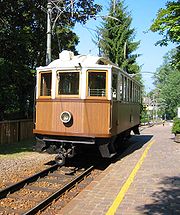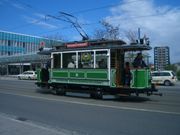
Bow collector
Encyclopedia

Tram
A tram is a passenger rail vehicle which runs on tracks along public urban streets and also sometimes on separate rights of way. It may also run between cities and/or towns , and/or partially grade separated even in the cities...
cars to transfer electric current
Electric current
Electric current is a flow of electric charge through a medium.This charge is typically carried by moving electrons in a conductor such as wire...
from the wires above to the tram below. While once very common in continental Europe
Europe
Europe is, by convention, one of the world's seven continents. Comprising the westernmost peninsula of Eurasia, Europe is generally 'divided' from Asia to its east by the watershed divides of the Ural and Caucasus Mountains, the Ural River, the Caspian and Black Seas, and the waterways connecting...
, it has now been largely replaced by the pantograph
Pantograph (rail)
A pantograph for rail lines is a hinged electric-rod device that collects electric current from overhead lines for electric trains or trams. The pantograph typically connects to a one-wire line, with the track acting as the ground wire...
.
Origins
When the bow collector was first conceived by German inventor Ernst Werner von SiemensErnst Werner von Siemens
Ernst Werner Siemens, von Siemens since 1888, was a German inventor and industrialist. Siemens' name has been adopted as the SI unit of electrical conductance, the siemens...
in the late 1880s, American inventor Frank J. Sprague
Frank J. Sprague
Frank Julian Sprague was an American naval officer and inventor who contributed to the development of the electric motor, electric railways, and electric elevators...
of Virginia
Virginia
The Commonwealth of Virginia , is a U.S. state on the Atlantic Coast of the Southern United States. Virginia is nicknamed the "Old Dominion" and sometimes the "Mother of Presidents" after the eight U.S. presidents born there...
had just patented his trolley pole
Trolley pole
A trolley pole is a tapered cylindrical pole of wood or metal, used to transfer electricity from a "live" overhead wire to the control and propulsion equipment of a tram or trolley bus. The use of overhead wire in a system of current collection is reputed to be the 1880 invention of Frank J....
system of current collection from an overhead wire. To avoid contravening this patent, the Siemens company was forced to design its own, unique form of current collection, namely the bow collector. The bow collector was first used by the Siemens
Siemens AG
Siemens AG is a German multinational conglomerate company headquartered in Munich, Germany. It is the largest Europe-based electronics and electrical engineering company....
electric company in its early electric tram
Tram
A tram is a passenger rail vehicle which runs on tracks along public urban streets and also sometimes on separate rights of way. It may also run between cities and/or towns , and/or partially grade separated even in the cities...
cars in either the late 1880s or early 1890s. The Hobart
Hobart
Hobart is the state capital and most populous city of the Australian island state of Tasmania. Founded in 1804 as a penal colony,Hobart is Australia's second oldest capital city after Sydney. In 2009, the city had a greater area population of approximately 212,019. A resident of Hobart is known as...
electric tramway system - the first of its kind in the Southern Hemisphere
Southern Hemisphere
The Southern Hemisphere is the part of Earth that lies south of the equator. The word hemisphere literally means 'half ball' or "half sphere"...
, opened in 1893 - used Siemens cars with very early bow collectors. Many other continental European and some English
England
England is a country that is part of the United Kingdom. It shares land borders with Scotland to the north and Wales to the west; the Irish Sea is to the north west, the Celtic Sea to the south west, with the North Sea to the east and the English Channel to the south separating it from continental...
tramway systems also used this method.
Construction

Wire
A wire is a single, usually cylindrical, flexible strand or rod of metal. Wires are used to bear mechanical loads and to carry electricity and telecommunications signals. Wire is commonly formed by drawing the metal through a hole in a die or draw plate. Standard sizes are determined by various...
or steel bars bent into a rectangular shape and mounted long-side-down on the tramcar roof. The height of the collector was such that its top edge would scrape along the wire above. The top section is made of a 1 inch broad (or thereabouts) steel rod, machined to have a bow-shaped cross section, hence the name. This bow shaped rod is referred to as the 'collector plate', and in later models may be up to several inches wide. Unlike many trolley poles, the bow collector does not normally have a revolving base (one exception was in Rome, where the entire assembly could be revolved), but is rather fixed centrally to the tramcar roof.
In the late 1900s the simple framing methods mentioned above were gradually replaced by more complex and sophisticated methods, but the general mode of operation remained the same. The changes of design are most noticeable on systems where both double- and single-deck cars were used on the same system. Single deck trams usually have tall and lightly constructed collectors with complicated frames to support the heavy cast-steel collector plate, while double deck cars usually have heavier collectors with less complicated frames.
To maintain good electrical contact, the bow collector must exert quite strong pressure on the wire above, and so complicated systems of springs or weights were put into use to ensure good electrical contact, and hence efficient operation was maintained.
The steel rails on the tracks act as the electrical return
Ground (electricity)
In electrical engineering, ground or earth may be the reference point in an electrical circuit from which other voltages are measured, or a common return path for electric current, or a direct physical connection to the Earth....
.
Operation
Properly the bow collector should be mounted in such a way so that the top edge of the collector plate would rise several inches above the wire when the collector frame is standing straight up. Thus the collector usually leans opposite to the direction of travel; when the time comes to travel in the opposite direction, the collector must be swung over. To allow this to happen, the overhead wire must be raised by several inches at places where the bows are swung over, such as terminals and turn-outs. This operation is usually achieved by ropes and pulleys. The collector is folded down to a horizontal position when the car is not in use.Some early cars had no means to swing the bows over. It was thought that this would happen automatically when the tramcar started travelling the other way, but collectors such as these were a failure.
Most Soviet trams (of which some are still in use in ex-USSR) had no means to swing the bows over. These trams were not designed to travel two ways. Another example is KTV-55-2 tramcar which had two bow collectors for the two directions of travelling.
Advantages and Modern Usage
The bow collector has fewer moving parts than the trolley pole, but is heavier and sometimes more complicated to construct. The construction of overhead wires for bow collectors is simpler than trolley pole wiring. As bow collectors do not have revolving mountings, the collector cannot jump off the wire or follow the wrong one at intersections, as trolley poles sometimes do. Thus overhead 'frogs' and guides for trolley poles are not necessary with bow collectors. Bow collectors are, however, much noisier than trolley poles.The overhead wires for bow collectors are stretched tighter than for trolley poles, and straight sections are 'staggered', that is, the wire does not run completely straight down the centreline of the track, but rather zig-zags slightly across a small distance. This distributes wear across the bow collector's collector plate, and extends the collector's life.
In addition to some vintage tramways, bow collectors are still used in some tram systems in the former Soviet Union, e. g., in Kazan
Kazan
Kazan is the capital and largest city of the Republic of Tatarstan, Russia. With a population of 1,143,546 , it is the eighth most populous city in Russia. Kazan lies at the confluence of the Volga and Kazanka Rivers in European Russia. In April 2009, the Russian Patent Office granted Kazan the...
, Minsk
Minsk
- Ecological situation :The ecological situation is monitored by Republican Center of Radioactive and Environmental Control .During 2003–2008 the overall weight of contaminants increased from 186,000 to 247,400 tons. The change of gas as industrial fuel to mazut for financial reasons has worsened...
, and Dzerzhinsk
Dzerzhinsk, Russia
Dzerzhinsk is a city in Nizhny Novgorod Oblast, Russia, situated along the Oka River, about east of Moscow. Population: The city is named after Feliks Edmundovich Dzerzhinsky, a Polish Bolshevik leader who was the first head of the Cheka ....
. They are also used by the Snaefell Mountain Railway
Snaefell Mountain Railway
The Snaefell Mountain Railway is an electric mountain railway on the Isle of Man in Europe. It joins the town of Laxey with the summit of Snaefell, at above sea level the highest point on the island. It connects with the Manx Electric Railway in Laxey. The line is long, built to gauge and...
on the Isle of Man.
See also
- Contact shoeCurrent collectorElectric current collectors are used for trolleybuses, trams, electric locomotives or EMUsto lead electrical power from overhead lines or electrical third rails to the electrical equipment of the vehicles....
- Overhead linesOverhead linesOverhead lines or overhead wires are used to transmit electrical energy to trams, trolleybuses or trains at a distance from the energy supply point...
- PantographPantograph (rail)A pantograph for rail lines is a hinged electric-rod device that collects electric current from overhead lines for electric trains or trams. The pantograph typically connects to a one-wire line, with the track acting as the ground wire...
- Third railThird railA third rail is a method of providing electric power to a railway train, through a semi-continuous rigid conductor placed alongside or between the rails of a railway track. It is used typically in a mass transit or rapid transit system, which has alignments in its own corridors, fully or almost...
- Trolley poleTrolley poleA trolley pole is a tapered cylindrical pole of wood or metal, used to transfer electricity from a "live" overhead wire to the control and propulsion equipment of a tram or trolley bus. The use of overhead wire in a system of current collection is reputed to be the 1880 invention of Frank J....

